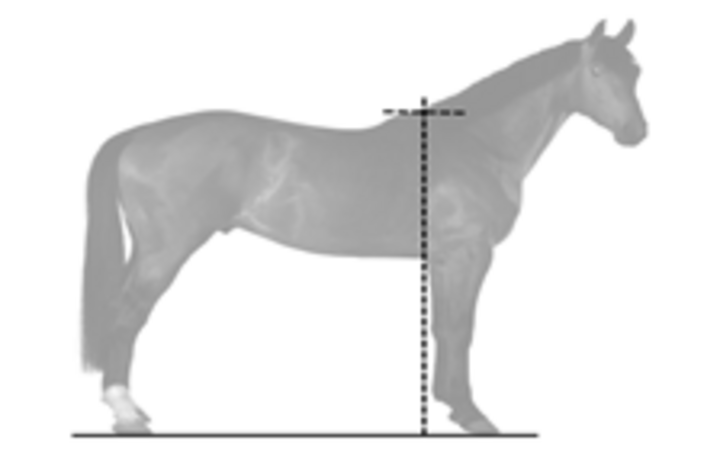It is recommended that the management of each 4-H Horse Show or event incorporate the following general rules as a part of show regulations:
- Only mares and geldings may be shown at halter and under saddle.
- Only 4-H horses that have been properly identified (all horse markings are drawn on the ID sheet or clear photos are included to show all marketings) on 4-H form F 2-97-77 through the Extension office in the county where the exhibitor is enrolled in 4-H may be shown. Horses cannot be identified in more than one county.
- Horses measured under 14.2 hands will be considered ponies. Measurements will be taken on a flat surface from the ground to the highest point of the withers, behind the point of the elbow.
Measuring Diagram

- A 4-H armband is required in Nebraska 4-H Horse Shows. The armband is to be worn on the left arm above the elbow, with the stem of the clover pointing downward. Failure by an exhibitor to wear armband correctly shall result in the exhibitor being penalized by lowering one ribbon placing.
- Each exhibitor should be issued two identical contest numbers. Halter exhibitors should fasten one number on their back. Western riders should pin one number on the right rear saddle skirt or blanket and one number on the left saddle skirt or blanket. Hunter/Saddle Seat riders may fasten number on their back or on one numbe ron each side of the saddle pad. Failure by an exhibitor to wear correct number(s) in a visible manner shall result in the exhibitor being penalized by receiving a white ribbon.

- Exhibitors and volunteers are expected to follow the 4-H Code of Conduct (found at 4h.unl.edu/policy-handbook/section-6). Unnecessary roughness or discourteousness will dismiss the exhibitor and/or volunteer from further participating for the entire show or contest.
- In any approved class, the judge shall have the authority to require the removal or alteration of any piece of equipment which, in the judge’s opinion, is unsafe, gives a horse an unfair advantage or is deemed inhumane.
- Notice of need for aids for youth with disabilities (ADA), including actions needed by assistants, should be provided by the contestant as part of their entry material prior to the start of the show or contest. Request for use of aids for youth with disabilities should be accompanied with a medical doctor’s statement indicating the need related for use in such activities. Show management should inform the judge and exhibitor as to conditions of use for any such requested aids
- Use of communication devices, i.e. electronic or radio devices, other than those approved for use by youth with disabilities (ADA), is considered a method to obtain unfair advantage, can be penalizedand can be grounds for disqualification at the discretion of the judge.
- All horses are to be ridden astride. The exhibitor will be disqualified and dismissed from the arena for a performance class if their horse falls (shoulder and haunches on same side on ground) and/or if the rider is dismounted from the horse prior to completion of the performance, i.e. judges placing turned into show management or completions of speed event run.
- Reruns will not be allowed in instances of equipment failure. When an exhibitor equipment failure causes delay or a run to be discontinued, the judge will disqualify the entry and the entry will receive a white ribbon.
- The judge or designated show official has the authority to excuse from competition any horse deemed unsafe and/or out of control. This includes any area or any time while on the show grounds, including times when the entrant is in line-ups or preparation areas for entering the arena for exhibition.
- Any surgical procedure that could affect the horse’s performance or alter its natural conformation or appearance is prohibited, except for those surgical procedures performed by a duly licensed veterinarian for the sole purpose of protecting the health of the horse or to resolve the effect of an accident or injury. Upon discovery of the administration of prohibited surgical procedures, the show management shall immediately disqualify the horse and report the matter to the Nebraska 4-H Horse Advisory Committee.
- Prohibited medication, drug, mechanical device or artificial appliance. No person shall cause to be administered internally or externally to a horse, either before or during an approved event, any medication, drug, mechanical device or artificial appliance which is of such character as could affect its performance or appearance at that event, EXCEPT FOR THOSE CONDITIONALLY PERMITTED THERAPEUTIC MEDICATIONS, THE USE OF WHICH IS SPECIFICALLY PROVIDED FOR IN THE THERAPEUTIC MEDICATION ADDENDUM AND NOT OTHERWISE PROHIBITED BY GOVERNMENTAL REGULATIONS. Upon discovery of administration of such drug, medication, mechanical device or artificial appliance, show management shall immediately report the matter to Nebraska 4-H Horse Show Officials. Any action or substance, administered internally or externally, whether drugs or otherwise, which may interfere with the testing procedure, or mask or screen the presence of such drug, is forbidden. The exhibitor or below specified individuals are responsible for a horse’s condition and presumed to know all of the rules and regulations of the Nebraska 4-H Horse Show and Judging Guide, whether or not they had actual knowledge of the presence of a forbidden drug, directly participated in the administration thereof, innocently miscalculated its retention time in the horse’s system or any other reason for its presence is established.
- Presence of such medication or drug in a horse participating in a Nebraska 4-H Horse-approved event shall be grounds for the Nebraska 4-H Horse Advisory Committee to take the following action if it is determined that the use of said drug or medication was not within the guidelines set forth in the Therapeutic Medication Addendum following subsection of this rule:
- The horse shall be disqualified from all classes in which it participates at the show.
- Bar the youth and horse from participation in further Nebraska 4-H county fair, Fonner Park State 4-H Horse Exposition and 4-H Rodeo for a 1 year (12 month) period from the date of notification.
- Upon request, the owner shall deliver the horse’s Nebraska 4-H identification papers to the respective county Extension office to be held during the period of the horse’s suspension from participation. Although ownership of such horse may, thereafter, be transferred to another party, the transfer of ownership will not dissolve or shorten the terms of the suspension.
- Every exhibitor shall, upon request of show management or Nebraska 4-H Horse Show Official, permit a specimen of urine, saliva, blood, or other substance to be taken for testing, and refusal to comply with such request shall constitute grounds for immediate disqualification of the horse from further participation at the show If the laboratory report on the chemical analysis of saliva, urine, blood or other sample taken from the horse indicates the presence of a forbidden drug or medication, this shall be taken as evidence that such substance has been administered to the horse either internally or externally.
- An individual is absolutely responsible for a horse’s condition if:
- They designate themselves on the entry blank as exhibitor, or authorizes another to designate them as exhibitor on the entry blank.
- They sign the entry blank on behalf of themselves or another, or causes an agent or representative to sign it.
- They physically participate in the event by riding or showing the horse; or
- They are the actual trainer, having presented or caused to be presented the horse at the show grounds for exhibition. Both the exhibitor designated on the entry blank and one having actual possession of the horse while physically participating with the horse in the event are conclusively presumed to be authorized by the owner to execute all documents, necessary or convenient, to allow the horse’s participation in a Nebraska 4-H Horse-approved event, including documents pertaining to drug testing.
- Tails may be lengthened by hair-to-hair attachment only with no attachments of any kind to the tailbone.
- The use of earplugs or cotton in the horse’s ears is acceptable.
- Presence of such medication or drug in a horse participating in a Nebraska 4-H Horse-approved event shall be grounds for the Nebraska 4-H Horse Advisory Committee to take the following action if it is determined that the use of said drug or medication was not within the guidelines set forth in the Therapeutic Medication Addendum following subsection of this rule:
- Lameness - The judge shall examine and check all horses brought into any class for lameness. Obvious lameness shall be cause for disqualification and receive the lowest ribbon placing (generally white ribbons). Obvious lameness is:
- Consistently observable at a trot under all circumstances;
- Marked nodding, hitching, or shortening of stride;
- Minimal weight-bearing in motion and/or at rest and inability to move.